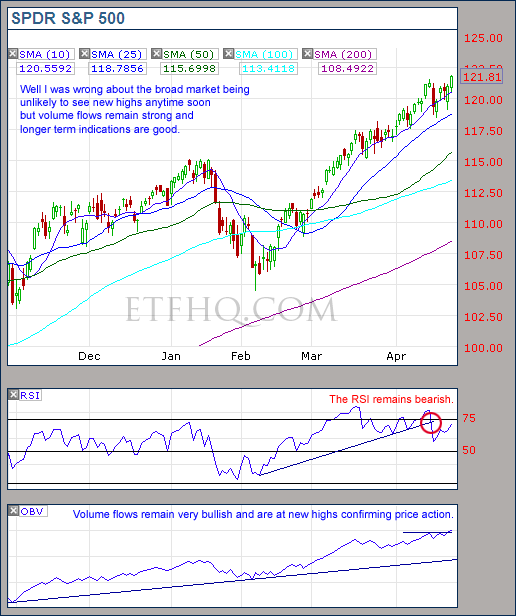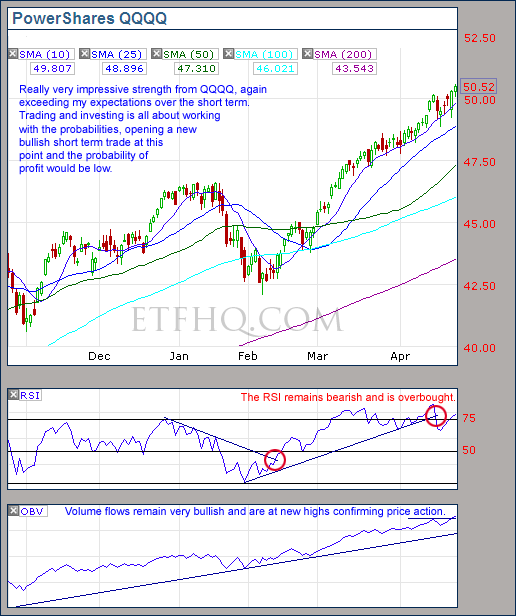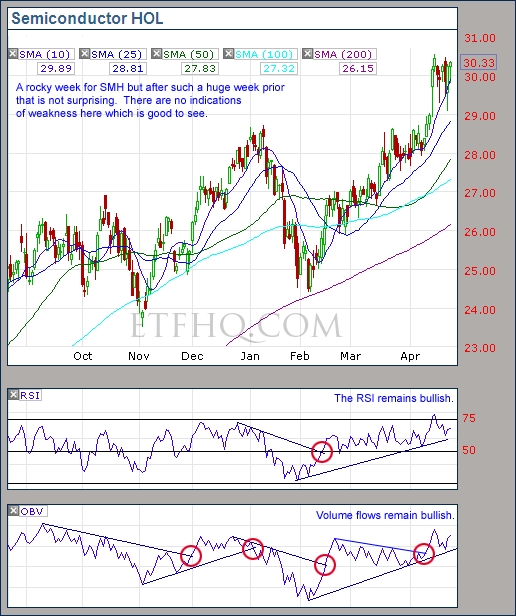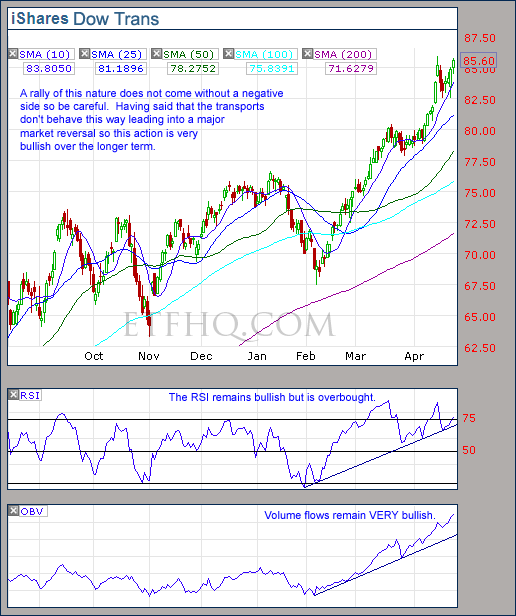April 26, 2010 – 08:45 am ET
Well I was simply wrong about the markets ability to see new highs so soon and that is all there is to it. I underestimated the strength of the rally and was very surprised to see things moving higher with such vigor over the last week. Short term weakness has been a likely outcome for a while now but the market has refused to see anything of the sort. This is very frustrating for those still sitting on the sidelines and pleasantly surprising for those of us reaping the benefits.
.
ETF % Change Comparison
.

As you can see all of the influential ETFs except SMH are sitting at new peaks. SMH was the worst performer over the last week but the best over the last two weeks. It is nice to see IWM, IYT, SMH and QQQQ with the highest performance ranks as this shows the more economically sensitive areas of the market are leading it higher.
.
What the % Comparison Table Tells Us:
By comparing the performance of the economically sensitive (SMH, QQQQ, IWM, IYT) and the comparatively stable ETFs (SPY and DIA) we can get an indication of the true market direction. The more sensitive areas of the market tend to be the first to initiate a trend change. For example if DIA and SPY sell off heavily while SMH and IWM (Russell 2000 small cap ETF) sell of mildly or continue moving to new highs then this would be very positive and vice versa.
The ‘Average Rank %’ is calculated by subtracting the % change for each ETF from the maximum % change and dividing it by the range for each period. 1-((MAX(% change all ETFs)-ETFs % Change)/(MAX(% change all ETFs)-MIN(% change all ETFs))) The readings for each period are then averaged. This reading is provided because if one ETF was significantly under/out performing the others then a plain high or low rank would not accurately reflect this.
.
![]()
.
A Look at the Charts
.

The RSI remains bearish on SPY but all other indications are strong particularly over the longer term.
.

You have to go back to the 90s before you find rallies that look like this one. Volume flows are strong but new short term bullish trades are just too risky.
.

I will be keeping a close eye on SMHs ability to maintain its volume trend and bullish RSI but for now all signs are positive.
.

This rally just takes your breath away, it is easy to make money when the market is behaving like this. As with SMH I will be keeping a close eye on IWMs volume trend and RSI. The fun will be over eventually.
.

IYT continues to confirm the strength of the bull market and has very strong volume flows.
.
![]()
.
OM3 Weekly Indicator
.

All indications remain bullish here but these buy signals have been active for two months now which makes them statistically old.
.
How to read the OM3 indicator
The OM3 indicator as with most of our models primarily reads price action and volume. The strong/weak buy/sell signals are self-explanatory. ‘No Signal’ means that the component readings are in conflict and cancel each other out.
The alerts let you know if the cycle is speeding up or slowing down, so when you get at ‘Strong Buy, Bear Alert’ for instance it simply means that the criteria for a strong buy is in place but this weeks cycle reading is weaker (or more bearish) than last weeks reading (the same is true in reverse).
The number of weeks that a signal has been repeated is displayed. Historically a ‘Strong Buy’ signal has lasted for an average of 6 weeks and a maximum of 42 weeks, while a ‘Strong Sell’ has lasted for an average of 4 weeks and a maximum of 16.
This is an indicator not a mechanical trading model. It is useful to assist in analyzing the market but for the best results should be combined with commonsense and support/resistance levels etc.
.
![]()
.
TransDow & NasDow
.

The Transports remain dominant over the Dow and have doubled the Dow’s returns during the last 56 days. The Dow is dominant over the NASDAQ and has about matched the performance of the NASDAQ over the last 42 days.
.
What the TransDow Readings tell us:
The TransDow measures dominance between the DJ Transportation Index (DJTI) and the Dow Jones Industrial Average (DJIA). In a strong market the more economically sensitive Transportation Index should be dominant over the DJIA.
Historically the DJTI has been dominant over the Dow 45% of the time. The annualized rate of return from the DJTI during this period was 18.47% with the biggest loss for one trade sitting at -13.27%. The annualized return from the DJIA during the periods it was dominant over the DJTI was just 4.06% and the biggest loss for one trade was -16.13%. A 4% stop-loss is applied to all trades adjusting positions only at the end of the week.
What the NasDow Readings tell us:
The NasDow measures dominance between the NASDAQ and the DJIA. Using the same theory behind the Trans Dow; in a strong market the more economically sensitive NASDAQ should be dominant over the DJIA.
Historically the NASDAQ has been dominant over the DJIA 44% of the time. Taking only the trades when the NASDAQ is above its 40 week moving average the annualized rate of return was 25.47% with the biggest loss for one trade sitting at –8.59%. The annualized rate on the DJIA during the periods it was dominant over the NASDAQ is just 8.88% and the biggest loss for one trade was –12.28%. A 8% stop-loss is applied to all trades adjusting positions only at the end of the week.
.
![]()
.
LTMF 80 & Liquid Q
.

LTMF 80’s trade on QQQQ remains open and is showing a return of almost 20% while Liquid Q remains in cash.
.
Historical Stats:
.

.
How The LTMF 80 Works
LTMF stands for Long Term Market Forecaster. It reads volume flows relative to price action and looks for out performance of volume measured on a percentage basis over the prior 12 months. During a sustained rally the readings will reach high levels (near 100%) making it imposable for the volume reading to always outperform price so any reading above 80% will maintain the buy signal. This system has outperformed the market over the last 10 years but performance has been damaged by some nasty losses. It only produces buy signals and only for QQQQ.
How Liquid Q Works
Liquid Q completely ignores price action and instead measures the relative flow of money between a selection of economically sensitive and comparatively stable ares of the market. It looks for times when the smart money is confident and and can be seen by through volume investing heavily is more risky areas due to an expectation of expansion. This system has outperformed the market over the last 10 years and remained in cash through most of the major declines. It only produces buy signals and only for QQQQ. We will provide more performance details on the web site for these systems soon.
.
![]()
.
Summary
.
The longer this rally defies gravity the more impatient, emotional people are going to jump on board and ultimately this will lead to a sharper and more painful pull back. There are currently no bearish indications long term but the risk over the short term should not be ignored despite the recent exceptional performance. Be decisive and only take action when you have probability on your side.
.
Any disputes, questions, queries, comments or theories are most welcome in the comments section below.
.
Derry
And the Team @ ETF HQ
“Equipping you to win on Wall St so that you can reach your financial goals.”
.
P.S Thanks to those who shared their thoughts on the Goldman Sachs ‘fraud’. Bill Fleckenstein wrote an exceptional article called Goldman-deal gamblers knew the score. He makes some great points including:
- “Among professionals, the fact that somebody else has a different opinion usually isn’t enough to change one’s viewpoint.”
- “Let’s say the housing market hadn’t melted down… can you imagine the SEC today suing Goldman Sachs because it hadn’t disclosed to Paulson that the buyers had picked some of the securities?”
- “If the SEC really wants to get at the culprits of this deal, it ought to go after the ratings agencies, as should Congress.”
- “The SEC also ought to consider pursuing the Financial Accounting Standards Board for helping denigrate accounting standards to the point that so much smoke and mirrors could pass for legitimacy.”
Rating Agency Data Aided Wall Street in Deals – Another article worth reading that explains how rubbish investments achieved such high ratings. It turns out that banks were given the ‘secret formulas’ by the rating agencies so they could start with the answer and work backwards, reverse-engineering their investments for a top rating.
P.S.S Like ETFHQ on Facebook – HERE
.
![]()
.
The Devils Dictionary – I.
.
Initial Public Offering – An exit route for alternative investment managers who expect the jig is up.
Insider Trading – Just good research.
Institutional Investor – Investor who’s now locked up in a nuthouse.
Investment Bankers – Financiers who find clever and original ways to put their own interests before those of their clients.
Investment Banks – Wall Street firms that find clever and original ways to bring the financial system to the brink.